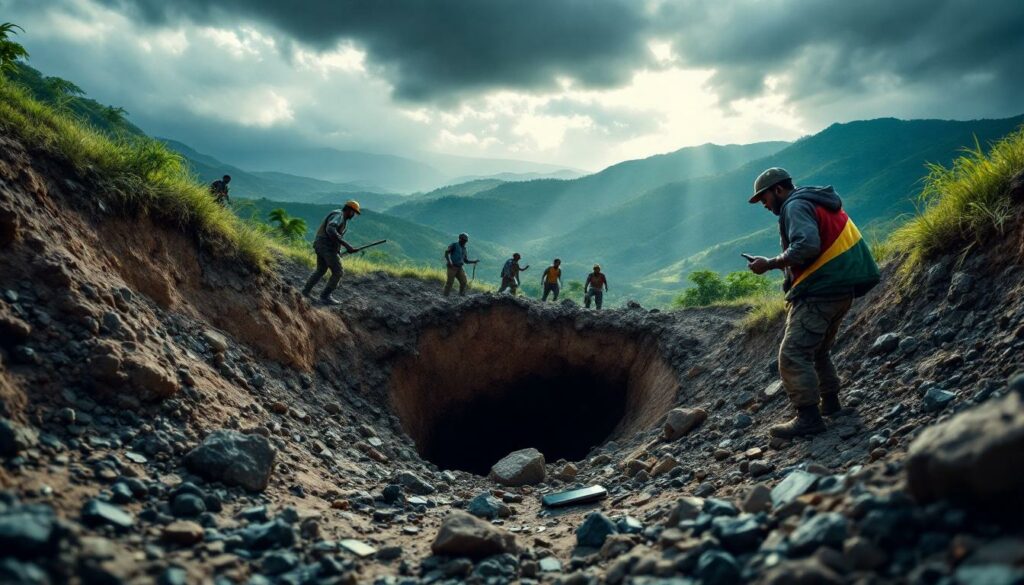The Deadly Reality of Coltan Mining: DRC Mine Collapse Claims 12 Lives
On June 19, 2025, tragedy struck in eastern Democratic Republic of Congo when an artisanal coltan mine collapsed near Rubaya in North Kivu province. At least 12 miners lost their lives while dozens managed to escape the collapse. The incident highlights the persistent dangers faced by workers in the region's artisanal mining sector and underscores broader issues of safety, security, and resource exploitation in conflict-affected mining zones.
What Happened at the Coltan Mine in Eastern Congo?
The Fatal Collapse: Key Details and Immediate Impact
The collapse occurred on Thursday afternoon in a remote mining area near Rubaya, a significant coltan mining hub in North Kivu province. According to MINING.COM, at least 12 miners were killed while dozens managed to escape as tunnels gave way. The miners were working in deep, hand-dug tunnels typical of artisanal operations when the collapse happened.
"The rescue efforts were hampered by limited equipment and the remote location of the mine," reported a civil society source who requested anonymity due to security concerns. "Many of the victims were trapped deep underground with no emergency exits or safety chambers."
Local authorities confirmed that the exact cause of the collapse remains under investigation, though preliminary assessments point to inadequate tunnel support structures and possible geological instability in the area. No early warning systems were in place, leaving miners with little time to evacuate when the first signs of danger appeared.
Understanding Artisanal Mining in the Region
The mines around Rubaya represent a crucial source of global coltan, producing approximately one-sixth (16.7%) of the world's supply according to MINING.COM. Unlike industrial mining operations with engineered safety systems, artisanal mines typically operate with minimal infrastructure and limited safety preparation tips.
These operations involve miners working with basic hand tools, digging tunnels that often reach dangerous depths without proper structural reinforcement. Workers frequently operate without personal protective equipment, ventilation systems, or emergency response plans.
"Artisanal mining provides essential livelihoods but at substantial personal risk," explains mining safety expert Jean-Pierre Mutombo. "Miners face daily dangers from tunnel collapses, oxygen deprivation, and toxic gas exposure, yet economic necessity drives them to accept these hazards."
The casualty figures from this latest tragedy are unfortunately consistent with the dangerous pattern observed throughout eastern Congo's artisanal mining sector, where safety is routinely compromised by economic pressure and lack of regulatory oversight.
Why Is Coltan Mining Important in the DRC?
The Strategic Importance of Coltan
Coltan (columbite-tantalite) is a metallic ore crucial for manufacturing smartphones and electronic devices worldwide. Its value stems from containing tantalum, an element essential for creating capacitors in modern electronics. These capacitors store electrical charges in devices ranging from mobile phones to advanced medical equipment.
The DRC holds a dominant position in global coltan reserves, with North Kivu province being particularly rich in high-grade deposits. This concentration of a strategic resource in a conflict-affected region has led to coltan's designation as a "conflict mineral" under international frameworks, including the Dodd-Frank Act in the United States.
The mineral's unique properties make it virtually irreplaceable in modern technology manufacturing chains. Tantalum capacitors offer exceptional performance in miniaturized electronics, making coltan a critical resource for technology companies worldwide.
Economic Significance for Local Communities
For communities in eastern Congo, coltan mining represents a vital economic lifeline. Thousands of artisanal miners depend on coltan extraction for their daily survival in a region with extremely limited formal employment opportunities.
A typical artisanal miner might earn between $3-10 per day depending on their findings—significantly more than many alternative occupations in the region. This income supports extended families and drives local economies through secondary businesses like food vendors, transportation services, and trading operations.
"The mining sector creates an economic ecosystem in areas with few alternatives," notes economist Claudine Bashengezi of the University of Goma. "Despite the dangers and exploitation, many communities would face catastrophic poverty without these mining activities."
The economic dependency on mining makes addressing safety concerns particularly challenging. Miners often resist safety measures that might reduce immediate productivity, even when aware of the dangers they face.
How Does Conflict Affect Mining Operations in Eastern Congo?
Current Security Situation in North Kivu
The security landscape in North Kivu directly impacts mining operations and safety. According to MINING.COM, M23 rebels have controlled the Rubaya mining area since mid-2024, imposing a 15% tax on the value of coltan production. This rebel presence creates a complex operating environment where miners work under unofficial authority structures.
The rebel group's control extends beyond simple taxation into broader governance of the area, including who can access mining sites and under what conditions. Local government authorities and regulatory bodies have minimal access to rebel-controlled territories, creating a governance vacuum regarding safety enforcement.
Humanitarian organizations report increased difficulty accessing mining zones to provide training or emergency services. The United Nations peacekeeping mission MONUSCO has documented restricted movement in mineral-rich areas under rebel control, further complicating safety oversight.
Impact of Rebel Control on Mining Safety
Under rebel governance, mining safety often becomes a secondary concern to production and taxation. With revenue generation as the primary focus, armed groups typically prioritize extraction speed and volume over worker protection.
"When armed groups control mining areas, safety regulations essentially disappear," explains conflict resources specialist Emmanuel Bahati. "Miners work under pressure to produce taxable minerals, often taking greater risks with less equipment."
The Rubaya collapse illustrates this dangerous dynamic. Without independent safety inspectors, mining operations frequently operate beyond safe capacity. Rebel administrators rarely invest tax revenue in infrastructure improvements that could prevent collapses, focusing instead on maximizing short-term production.
Communication between mining zones about safety incidents is also severely limited in conflict-affected areas, preventing the sharing of critical warnings about dangerous conditions or emerging hazards that might have prevented the recent tragedy. The complex geopolitical conflict dynamics in the region further complicate safety enforcement efforts.
What Are the Safety Challenges in Artisanal Mining?
Common Hazards in Coltan Mining Operations
Artisanal coltan mining presents multiple severe safety hazards. The most immediate danger comes from structural instability in hand-dug tunnels, which often extend 20-30 meters underground without proper engineering or support systems. These tunnels frequently follow mineral veins rather than being designed for stability.
Ventilation represents another critical challenge. Deep tunnels with limited air circulation create oxygen-depleted environments where carbon dioxide and other harmful gases can accumulate to dangerous levels. Miners rarely have access to air quality monitoring equipment or respiratory protection.
Water management poses additional risks. Underground water sources can rapidly flood tunnels or gradually weaken structural integrity. Most artisanal operations lack pumping systems or drainage engineering to manage water infiltration safely.
Exposure to harmful minerals presents long-term health hazards. Miners often work without masks or protective clothing while handling potentially radioactive materials associated with coltan deposits, leading to respiratory diseases and other chronic health conditions.
Comparison with Industrial Mining Standards
The contrast between artisanal operations and industrial mining standards is stark. Corporate mining operations typically implement comprehensive safety protocols including:
- Engineered tunnel support systems with regular integrity inspections
- Mechanical ventilation systems with air quality monitoring
- Professional geotechnical assessments before excavation
- Emergency response teams with specialized equipment
- Regular safety training and certification requirements
- Personal protective equipment for all personnel
- Medical facilities and evacuation procedures
Industrial operations invest in these systems because they're legally required to meet international safety standards and because they reduce costly disruptions to production. Artisanal mines, particularly those in conflict zones, operate outside these regulatory frameworks with minimal investment in safety infrastructure.
The result is a dramatic difference in incident rates. Industrial mines typically record fewer than 1 fatality per million hours worked, while artisanal operations in places like North Kivu experience casualty rates estimated to be 30-40 times higher, according to United Nations Environment Programme research.
What Are the Human Costs of Coltan Mining?
Worker Vulnerability and Exploitation
Miners in eastern Congo's coltan sector face extreme vulnerability. Without formal employment contracts or legal protections, they operate in a system that provides little recourse for exploitation or injury. Payment structures typically compensate miners only for minerals recovered, creating economic pressure to take dangerous shortcuts.
Child labour remains a persistent concern despite international attention. Economic necessity drives families to include children as young as 10 in mining activities, particularly in sorting and processing tasks. These children miss educational opportunities while being exposed to hazardous conditions.
"The exploitation cycle begins early," explains child protection advocate Marie Kyakimwa. "Children start by carrying water or sorting minerals, then gradually move into more dangerous underground work as teenagers, normalising the risks they face."
Health insurance or injury benefits are virtually nonexistent in artisanal operations. Injured miners typically receive no compensation and face catastrophic financial consequences when unable to work. Families of deceased miners, like those lost in the Rubaya collapse, generally receive no formal support or compensation.
Health and Environmental Impacts
The health consequences of coltan mining extend far beyond immediate safety risks. Miners develop chronic respiratory conditions from continuous exposure to mineral dust in poorly ventilated spaces. Without masks or dust suppression systems, silicosis and other lung diseases are common among long-term miners.
Water contamination creates widespread community health impacts. Mining waste containing heavy metals and processing chemicals frequently enters local water sources without treatment, exposing entire communities to toxic substances. Studies have found elevated levels of heavy metals in water sources near mining operations throughout North Kivu.
Deforestation accompanies mining expansion, as trees are cleared both for access to mineral deposits and to provide timber for tunnel supports. This habitat destruction threatens biodiversity in one of Africa's most ecologically sensitive regions while increasing erosion and landslide risks around mining sites.
The psychological toll on miners is less visible but equally significant. Working in constant danger creates chronic stress conditions, while witnessing accidents and deaths leads to widespread trauma among mining communities. Mental health support services are virtually nonexistent in these regions.
How Does the Global Supply Chain Connect to Local Mining Tragedies?
Following Coltan from Mine to Market
The journey of coltan from dangerous artisanal mines to consumer electronics involves a complex supply chain that often obscures the mineral's origins. After extraction, miners typically sell to local traders who aggregate materials from multiple sources, making traceability exceptionally challenging.
These local traders sell to regional buyers who transport the minerals to processing facilities, often crossing international borders through informal channels. By the time coltan reaches refineries that process it into tantalum, its specific source has frequently become impossible to verify with certainty.
The refined tantalum then enters global supply chains through component manufacturers who produce capacitors for electronics companies. The final products—smartphones, laptops, medical devices, and other electronics—reach consumers with little indication of the material's origins or the conditions under which it was mined.
This supply chain complexity creates significant challenges for companies attempting to ensure their materials come from responsible sources. The multiple intermediaries and mixing of materials from different mines makes verification difficult even with good intentions.
International Efforts to Address Mining Conditions
Multiple international frameworks have emerged to address the issues surrounding conflict minerals like coltan. The Dodd-Frank Act requires companies to disclose their use of conflict minerals from the DRC, creating regulatory pressure for supply chain due diligence.
The Responsible Minerals Initiative brings together over 400 companies to improve supply chain transparency through auditing programs and traceability systems. Their efforts include developing chain-of-custody documentation and third-party verification processes for mineral sources.
Fair trade certification programmes attempt to create market incentives for improved mining conditions. These initiatives establish standards for working conditions, environmental management, and community benefits, offering price premiums for certified materials.
Industry initiatives like the Solutions for Hope project have established closed-pipe supply chains for tantalum, creating direct relationships between mines with verified practices and end users. These systems bypass traditional trading networks to maintain traceability from mine to manufacturer.
Despite these efforts, challenges remain in ensuring these systems reach artisanal miners in conflict-affected regions. The recent tragedy in Rubaya demonstrates that many mining operations continue to operate outside these frameworks, particularly in areas under non-state control.
What Measures Could Prevent Future Mining Disasters?
Improving Artisanal Mining Safety
Practical approaches to improving artisanal mining safety must acknowledge the economic realities and conflict context in which these operations exist. Immediate safety improvements could include:
- Basic safety training programs delivered through local mining cooperatives
- Distribution of essential safety equipment like helmets, gloves, and respiratory protection
- Technical assistance on proper tunnel construction and supports
- Development of community-based emergency response capabilities
- Mobile health clinics specifically equipped to handle mining injuries
These interventions must be designed to work within existing constraints. For example, safety improvements should demonstrate immediate production benefits alongside risk reduction to encourage adoption in economically precarious environments.
Local knowledge and practices should be integrated into safety approaches rather than imposing external models. Experienced miners often have developed techniques for identifying warning signs of potential collapses that could be formalised and shared more widely through peer networks.
Governance and Regulatory Solutions
Longer-term solutions require addressing the governance challenges in mining regions. Support for formalisation of artisanal mining could create pathways for safety regulations that acknowledge the reality of small-scale operations rather than imposing industrial standards.
Creating incentives for safety improvements through market access represents a promising approach. Buyers who verify improved practices through certification or assurance programs can offer price premiums that offset the costs of safety investments.
International support for mining sector reforms must recognize the complex security situation. Development organizations can provide technical assistance to government agencies while working with non-state actors to improve conditions even in contested areas. Additionally, implementing modern mine planning techniques could significantly reduce risks even in artisanal operations.
Regional cooperation on mineral governance offers potential for improvement across borders. Harmonised approaches to registration, taxation, and safety standards between neighbouring countries could reduce incentives for smuggling and informal trade that currently undermine governance efforts.
FAQ: Coltan Mining in Eastern Congo
What is coltan and why is it valuable?
Coltan (columbite-tantalite) is a metallic ore containing tantalum, which is essential for manufacturing capacitors used in smartphones, computers, and other electronic devices. Its heat-resistant properties make it irreplaceable in many modern technologies. The mineral's concentrated presence in eastern Congo makes it economically significant despite the hazardous extraction conditions.
How widespread is artisanal mining in eastern Congo?
Artisanal mining employs hundreds of thousands of workers across eastern Congo, with operations ranging from individual miners to small cooperatives. These informal operations produce a significant portion of the region's mineral output, including approximately one-sixth of global coltan according to Yahoo News. The sector represents the primary livelihood for many communities in mineral-rich areas with limited alternative economic opportunities.
What role do rebel groups play in the mining sector?
Armed groups, including the M23 rebels currently controlling the Rubaya area, often tax mining operations or directly control mining sites to finance their activities. According to MINING.COM, M23 imposes a 15% tax on coltan production value. This creates a complex relationship between conflict and resource extraction, where mineral wealth funds armed groups while miners work under their authority with limited safety oversight or legal protections.
How does coltan mining affect local communities?
While providing essential income, coltan mining also creates environmental damage, safety risks, and social disruption. Communities near mining sites experience both economic benefits and significant challenges related to health, security, and land use. Water contamination from mining operations affects agricultural production and community health, while the influx of mining income creates economic disparities and social tensions. The recent collapse at coltan mine in eastern Congo demonstrates the catastrophic impact mining accidents can have on local families who lose breadwinners without compensation or support systems.
Further Exploration
Readers interested in learning more about coltan mining in the Democratic Republic of Congo can explore resources from organizations monitoring the situation, including the Enough Project's conflict minerals research and the OECD's due diligence guidance for responsible mineral supply chains. The recent tragedy underscores the urgent need for improved safety measures, governance solutions, and consumer awareness about the human costs behind essential technology materials. For a broader perspective on how the industry is evolving, examining current mining industry trends and mine reclamation practices can provide valuable context.
Ready to Catch the Next Major Mineral Discovery?
Discovery Alert's proprietary Discovery IQ model instantly alerts investors to significant ASX mineral discoveries, turning complex data into actionable insights with real-time notifications. Understand why major mineral discoveries can lead to significant market returns by exploring Discovery Alert's dedicated discoveries page, showcasing historic examples of exceptional outcomes.




